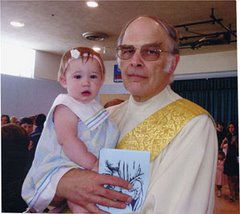Mark 5:21-43
This is a weird gospel, right? Two stories, one within the other, seemingly unrelated. Bible scholars call this “intercalation”, and you see it in the Old Testament in some stories. But in the New Testament, we only see it in Mark’s gospel, and he does this six or seven times, depending on how you count. But this is the most famous of the stories. It’s a very vivid story, and you can almost see what is going on from Mark’s description. Jarius wants to get Jesus to his daughter as soon as possible, and he is pushing through the crowd. But Jesus stops and says, “Who touched my cloak?” And then there’s the whole interacting with the woman who has been cursed with twelve years of bleeding. And this ends with people coming to tell Jarius that it’s too late, his daughter is dead.
Mark clearly wants us to link these stories. They are both about women who, notably, are not named. The woman with the bleeding problem would be excluded from marriage, would not be allowed in the synagogue, and would be almost like a leper. To add to her misery she is out of money. She is unclean, and forbidden to mingle among healthy people. And yet, she pushes forward and does the unthinkable-- she touches Jesus’ garment. The little girl is the opposite. She’s got some kind of acute illness and is at the point of death. Things are happening fast, which is why Jarius is so distraught. And after she dies, Jesus, who has been touched by an unclean person, touches a dead body -- at least we think she’s dead. They weren't stupid in those days and when the attendants come out to say she’s dead, they probably noticed that her breathing had stopped and that she had no pulse. When Jesus says she’s only sleeping, I think he’s reassuring Jarius, not making a statement of fact.
Both women are united by the number twelve. This is a special number for the Jewish people at that time. There were twelve tribes, twelve patriarchs, and twelve regions in Israel. There are twelve minor prophets in the bible. Elijah built his altar with twelve stones -- and I could go on. The little girl is twelve years old, and the woman with the bleeding problem has had the condition for twelve years. Twelve is a sign of completion. The bleeding woman has completed her sentence, in a way. The little girl ends her old life and starts on a new one. I think Mark wants us to recognize symbolically that the old order is out, the new one in. Jesus cannot be made unclean by being touched by a ritually unclean person, nor does he become unclean by touching a dead body. When God breaks into the human condition, all bets are off, you don’t know what he will do next, and your rules don’t count.
I think Mark has an important lesson for us in these two stories. It has to do with faith. The older woman had faith that if she touched Jesus’ garment she would be healed -- so she does. She receives the healing she desired, and was about to slink away, when Jesus calls out “who has touched my clothes?” Now if you were slinking away, you would probably continue to slink, right? After all, you got what you came for. But our woman drops to the floor and tells Jesus that she’s the one and then waits -- what will Jesus do, take back his healing? Reveal to the crowd that she is an unclean person? She is at his mercy. But despite fear and trembling she did come forward to answer his question. And that is Mark’s idea of faith. Faith is not simply believing something, it’s acting on that belief, even when you don’t know what will happen--or perhaps you do know, and it won’t be good, but you act anyway because it’s the right thing to do. In this case, the woman is rewarded. Jesus tells her that her faith has saved her. Before this of course she had felt herself to be cured when she touched his garment; but now Jesus confirms that she is cured.
The faith lesson continues. When the attendants tell Jesus and Jarius that the little girl is dead, Jesus said, “Do not be afraid, just have faith”. Faith in some sense is the opposite of fear. But in a sense it accompanies fear. Because to act on faith, which is real faith, remember, always involves taking a leap into the unknown. We don’t know what our action will accomplish -- maybe nothing at all, maybe we’ll be laughed at, which is what’s going on in this story. Jarius wouldn’t be wrong by saying, “Thanks for nothing, Jesus. Now leave me to my grief”. Because who can raise a dead person? But despite the ridicule, Jarius and his wife continue to act on faith, and the reward is that their daughter is restored to them.
Faith is acting despite not knowing the consequences of our actions. Faith is acting even when there is fear.
And of course we love that human touch of Jesus. They are all marveling at the miracle 00 the bedridden, indeed dead little girl is not just alive, she is up walking around. The sickness that had felled her is gone. She probably hasAn’t taken any food or drink since her illness started. And Jesus recognizes this and tells the parents, “Give her something to eat!”
In these two interwoven stories Mark teaches us about faith. During this coming week let us act on our faith -- we’ll have the opportunity. It will feel like fear.



































